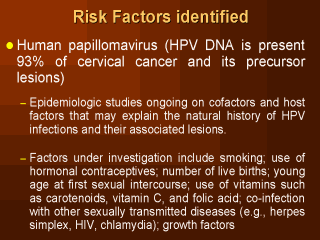 |
- Human papillomavirus (HPV) probably is the cause
of almost all cervical cancer worldwide HPV DNA is present in 93% of cervical
cancer and its precursor lesions- A recent study estimates worldwide HPV
prevalence in cervical carcinomas at 99.7 percent (Walboomers et al., 1999).
- Studies also suggest
that persistence of HPV infection is related to the development of cancer (Wallin, et al.
1999; Burk, 1999).
- Besides HPV, other risk
factors appear to include certain sexual activity patterns and smoking (Brinton, 1992;
Biswas et al., 1997; Prokopczyk et al., 1997, Roteli-Martins et al., 1998; Wen et al.,
1999).
- In some developing
countries, there is concern among clinicians that cervical cancer develops differently
from what is traditionally described in Western countries (for example, concern that
cervical cancer may develop at younger ages and that dysplasia progresses more quickly to
invasive disease) (Rogo et al., 1990).
- A study of Pap smear
results from ob/gyn clinics in South Africa found that a significant proportion of
cervical cancer cases occurred in women younger than age 40 (Lancaster et al., 1999).
Whether these results would have been the same with a true population-based sample is
unclear. Few studies have conclusively demonstrated regional differences in the
age-specific risk of cervical cancer; in general, cervical cancer risk peaks around age
50, and severe dysplasia risk peaks around age 35 (Ponten et al., 1995). |
